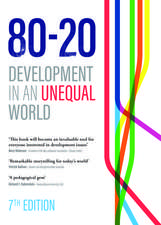Eurasian Corridors of Interconnection: From the South China to the Caspian Sea: Routledge Advances in Geography
Editat de Susan M. Walcott, Corey Johnsonen Limba Engleză Hardback – noi 2013
Preț: 1056.35 lei
Preț vechi: 1288.23 lei
-18% Nou
Puncte Express: 1585
Preț estimativ în valută:
202.20€ • 219.70$ • 169.95£
202.20€ • 219.70$ • 169.95£
Carte tipărită la comandă
Livrare economică 21 aprilie-05 mai
Preluare comenzi: 021 569.72.76
Specificații
ISBN-13: 9780415857710
ISBN-10: 0415857716
Pagini: 192
Ilustrații: 13 b/w images, 7 tables and 13 halftones
Dimensiuni: 152 x 229 x 18 mm
Greutate: 0.5 kg
Ediția:New.
Editura: Taylor & Francis
Colecția Routledge
Seria Routledge Advances in Geography
Locul publicării:Oxford, United Kingdom
ISBN-10: 0415857716
Pagini: 192
Ilustrații: 13 b/w images, 7 tables and 13 halftones
Dimensiuni: 152 x 229 x 18 mm
Greutate: 0.5 kg
Ediția:New.
Editura: Taylor & Francis
Colecția Routledge
Seria Routledge Advances in Geography
Locul publicării:Oxford, United Kingdom
Public țintă
Postgraduate and UndergraduateCuprins
1. Introduction: A Conceptual Overview Susan M. Walcott and Corey Johnson 2. Creating a Border Between China and Vietnam James Adams Anderson 3. Himalayan Hinterlands: Highland Axis of Asia Susan M. Walcott 4. Where Inner Asia Meets Outer China: the Xinjiang Uyghur Autonomous Region of China Stanley W. Toops 5. Russian Repositioning: Mobilities and the Eurasian Regional Concept Alexander C. Diener 6. Geographies of Obdurate Infrastructure in Eurasia: The Case of Natural Gas Corey Johnson 7. Islam as a Source of Unity and Division in Eurasia Matthew Derrick 8. Conclusion: Middle Ground Corey Johnson and Susan M. Walcott
Descriere
This volume aims to rethink the regional concept of "Eurasia" as a scale of analysis and as a geographical place, examining dynamic geopolitical links reconfiguring Eurasian spaces from the western edge of Europe through the eastern edge of Asia. While current debates presume that Eurasia is merely a catch-all term for bare ambition and geostrategic wrangling, seeing the Eurasian region from the perspective of the most powerful players, this volume presents a usefully broad vision of blurred borders - from the eastern edges of the Sino-Vietnamese zone through the Himalayan corridor and the Central Asian "near abroad" distinguished more by their syncretism than antagonism.

























